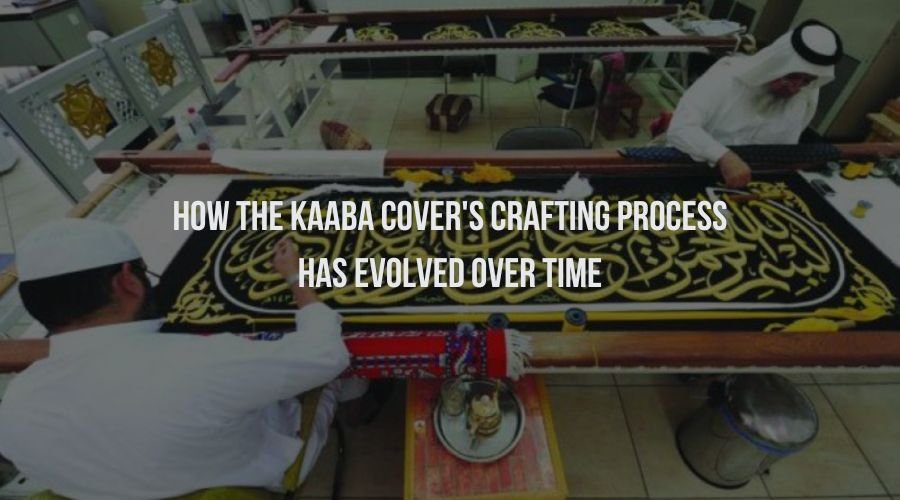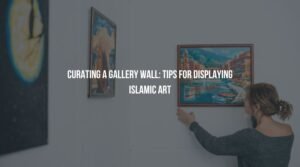The Kaaba, a cubical structure in Mecca, is the holiest site in Islam. Every year, millions of Muslims undertake the pilgrimage, or Hajj, to circumambulate this sacred building. Draped over the Kaaba is a magnificent cloth known as the Kiswah (also spelled Kiswa). This intricate covering, a symbol of reverence and unity, boasts a rich history that reflects the evolution of Islamic art and craftsmanship.
Early Kaaba Kiswa : Simple Beginnings
The history of the Kaaba Kiswa stretches back centuries. Early accounts suggest the Kaaba was adorned with simple coverings of linen or Yemenite fabric. As Islamic art flourished, the Kaaba Kiswa became more elaborate. By the 7th century, skilled artisans in Mecca and Yemen were crafting the cover using precious materials like silk and brocade. The process was incredibly labor-intensive. Artisans hand-stitched intricate Islamic calligraphy and geometric patterns onto the fabric, often incorporating gold and silver threads. This meticulous work imbued Kaaba cover with a profound sense of artistry and devotion.
Golden Age : Flourishing of Islamic Art
The rise of Islamic empires like the Abbasids and Ottomans ushered in a golden age for the Kiswah’s design and craftsmanship. Skilled artisans from across the Islamic world were commissioned to create the cover. This period saw the flourishing of Islamic art, characterized by geometric patterns, calligraphy, and intricate embroidery using precious materials like silk and gold thread.
The Kaaba cover became a canvas for showcasing the rulers’ wealth and devotion. The Abbasids, for example, incorporated black silk from Baghdad and golden embroidery depicting the Quranic verses. The Ottomans, renowned for their textiles, crafted Kiswahs with intricate floral patterns and Qur’anic inscriptions in gold and silver thread.
The Making of a Kaaba Kiswa
Creating the Kaaba cover was a collaborative and prestigious undertaking. Skilled weavers, embroiderers, and dyers worked meticulously for months, often under the patronage of a ruler. The process involved:
Weaving the Base Fabric
Large black silk panels were meticulously woven on special looms.
Embroidery
Expert embroiderers painstakingly stitched intricate Qur’anic verses, geometric patterns, and the belt (hizam) that encircles the Kaaba, using gold and silver thread.
Dyeing
Natural dyes like indigo were used to achieve the deep black color.
Maintaining Tradition with Innovation
Today, the tradition of crafting the Kaaba Kiswa continues under the supervision of the Saudi Arabian government. Highly skilled artisans, many from the al-Saddah family who have held the hereditary honor for generations, meticulously create the Kaaba cover in a dedicated workshop in Mecca.
Modern technology has streamlined some aspects of the process. Special machines weave the base fabric, but the intricate embroidery remains entirely hand-stitched. Materials like silk and gold thread are still used, ensuring the Kaaba Kiswa retains its luxurious feel and symbolic significance.
The Enduring Legacy of the Kaaba Kiswa
The evolution of the Kiswa’s crafting process reflects the changing times, yet its core purpose remains constant. It serves as a magnificent cloak of respect for the Kaaba, a symbol of unity for Muslims worldwide, and a testament to the enduring power of Islamic art and craftsmanship. The Kiswa’s journey, from hand-stitched silk to high-tech fabrics, is a fascinating chapter in Islamic history, reminding us of the enduring power of tradition and its ability to adapt and evolve.
Inspiration for Muslim Home Decor
The beauty and symbolism of the Kaaba cover can inspire those seeking to incorporate Islamic decor into muslim home decor.. Here are some ideas:
Geometric Patterns
Islamic decor is known for its intricate geometric patterns. You can incorporate these patterns into your muslim home decor through wall hangings.
Arabic Calligraphy
Arabic calligraphy adds a touch of elegance and religious significance to any muslim home decor. Consider framed calligraphy pieces or decorative items featuring verses from the Quran.
Black Accents
The black color of the Kiswa signifies unity. Use black accents in your muslim home decor, such as throw pillows, lamps, or picture frames, to create a sense of harmony and sophistication.
For a curated selection of Islamic decor inspired by the rich traditions of Islamic craftsmanship, consider exploring Kiswah Islamic Store.
By incorporating elements inspired by the Kiswa, you can create a space that reflects your faith and appreciation for Islamic art and culture. The evolution of the Kiswa’s creation serves as a reminder that tradition can be both beautiful and adaptable, just like the faith it represents.




